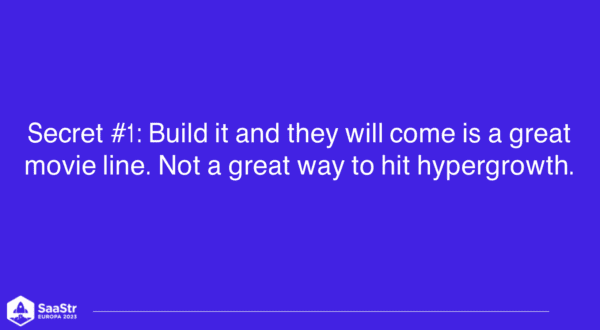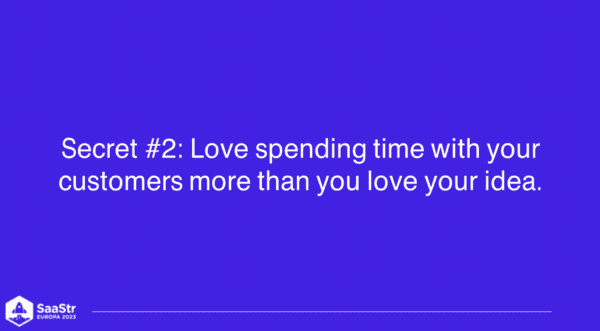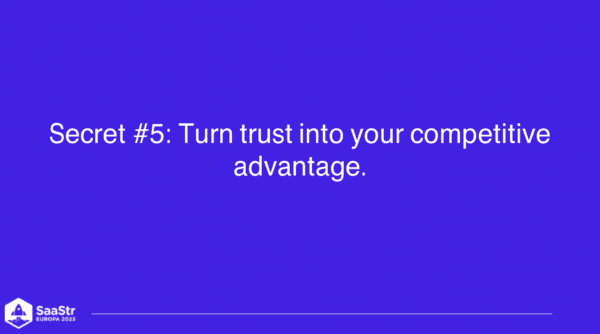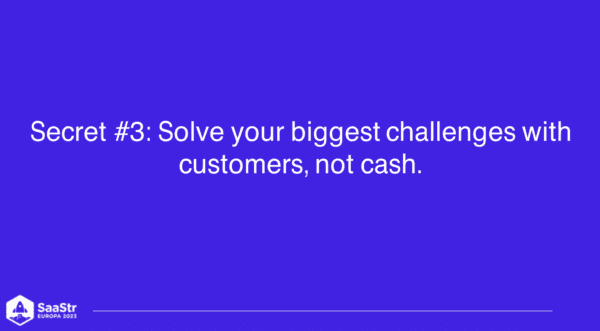Hypergrowth in today’s highly competitive and budget-constrained SaaS world may be less frequent now, but Vanta, the software tool empowering security companies to achieve compliance and manage risk, has defied the odds. With a multi-billion dollar valuation and a trajectory to double growth annually, Vanta is seizing the spotlight.
In this session, CEO and Founder Christina Cacioppo, and GM of EMEA Andrew Foley, reveal the strategies that have propelled Vanta’s remarkable scaling success despite the constraints of the capital-restricted environment.
Secret #1: ‘Build it, and customers will come in’ is not a great approach
Early in Cacioppo’s career, she built multiple products with little to no user insights. Even though she thought they were brilliant, most of the products didn’t get the attention of users.
“Most of us can’t pull off a Zuckerberg, walk into a dorm room, and build a product that millions of people use.”
Cacioppo went a different route when building Vanta—testing the idea before building, talking to potential users along the way, and showing people elements of the tool as she built it. This change in building process has led to Vanta being a successful product. Cacioppo now strongly believes that “customers would follow if you just build something” is a myth.

Secret #2: Love spending time with your customers
One of Cacioppo’s early conversations was with a member of the product security team at Dropbox. She learned that the best part of their week was working with product teams, helping keep products secure.
The least favorite part of their week, however, was putting together reports for customers, auditors, or the board showing that they had improved system security or patched bugs. Reporting being a disliked task is a user insight you can use if you’re a building security tool.
As a template, the question to a potential customer could be, “Look at your work calendar of last week. What were your favorite (and least favorite) parts of the week?” Knowing the answer will help you discover pain points and, at the same time, empathize with your customers.

Secret #3: Solve your biggest challenges with customers, not cash
When building a startup, whether you’re working with two, 20, or 200 team members, the common thread is that you’ll encounter many problems and opportunities. It’s helpful to understand that not all problems are ones that more money can help. For instance,the number one reason that startups fail is because they have no market need. Funding can’t create customer demand.
“Cash is not always king. Be clear about which problems cash can and can’t solve.”
Vanta, in its early stages, was powered by a lot of word of mouth, which meant they didn’t need to spend much money on Google ads. This is typically an area where cash matters for startups. But since they didn’t need it, instead of raising capital at an inflated valuation in late 2021, Vanta went for an adjusted-to-market valuation in mid-2022.
On the other hand, Vanta’s concern was that it could not onboard customers fast enough because they didn’t invest early enough in customer success. More money could have helped them onboard customers slightly faster, but the fundamental need for solving customer experience is understanding the customers you’re selling to (not more cash)
Pushing through customer onboarding with funding-assisted hiring might have helped get more customers in the door. But since Vanta had not yet solved their core problem-customer experience- it would have likely destroyed their positive word of mouth.
If you’re at a similar stage in your growth journey, diving into the post-sale process with an eye toward customer experience can help. Once you’ve solved the customer experience part of the puzzle (and it doesn’t necessarily need more money), you can focus on amping up your leads and customers.
Secret #4: Your customer today is (hopefully) not the customer you have tomorrow
If your business is serving startups, remember that your customers are growing too. What was a plucky group of founders a few years ago is likely now a growing behemoth.
“Think not just about serving the customers today but building for the customers of tomorrow and beyond.”
While your startup audience can remain your core customer (and you don’t need to abandon them), recognize their business growth over time and ensure your product development team is building to serve their evolving needs and attract bigger players in the market.
Secret #5: Turn trust into your competitive advantage
Trust is the ultimate competitive advantage—whether it’s building relationships with vendors or winning new deals.
“Do what it says on the tin. Imagine a cookie tin. Do what you say you’re going to do.”
By explaining how they keep products secure, Vanta’s security teams help win the trust (and business) of bigger companies, proving they are on top of things, and take customer data seriously.
In other sectors, too, your customers are delegating a part of their work or process with the expectation you’ll uphold the chain of trust. And if you do, that gained trust can open new markets and close new deals.

Key Takeaways
Achieving hypergrowth requires strategic planning and relentless execution. It’s attainable by following some ground rules to build a SaaS business. Here’s the recap from Vanta’s 5 fundamentals for achieving hypergrowth:
- Don’t build in isolation, hoping that customers will find you anyway.
- Evolve your ideas with customer conversations.
- Focus on solving customer problems first and cash problems later.
- Build with the future of your customer in mind.
- Secure the trust of your users to fuel growth.


